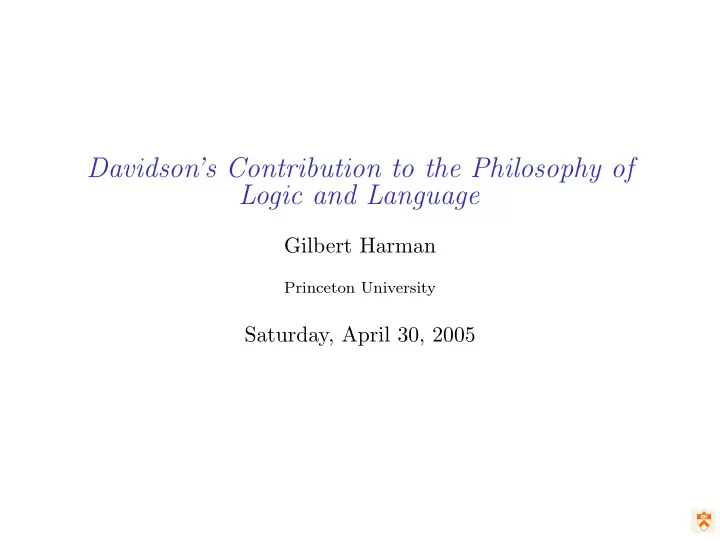

Davidson’s Contribution to the Philosophy of Logic and Language Gilbert Harman Princeton University Saturday, April 30, 2005
Finite Primitives ◮ believes-that-Socrates-was-a-philosopher (Scheffler) ◮ multiply oblique senses ◮ Socrates was a philosopher ◮ . . . believes that Socrates was a philosopher ◮ . . . says that Mary believes that Socrates was a philosopher ◮ walked-in, walked-in-at, . . . .
Semantic Structure ◮ Wanted: a semantic theory that explains semantic competence ◮ The theory must allow proofs of relevant T sentences of the form x is true iff p . ◮ It is not enough to have the T sentences as axioms ◮ Formulate additional constraints, such as only finitely many axioms, classical first-order logic ◮ Provide partial theories for fragments of natural language ◮ Action sentences: ( ∃ e )(walk( e )&agent(Jack , e )&in( e, thestreet )) ◮ Indirect quotation: Jack said that. Socrates was a philosopher.
Theory of Truth as a Theory of Competence ◮ Axioms for primitive predicates, connectives and quantifiers. ◮ Do the axioms for primitive predicates explain our semantic competence more than the following?—“red” means red , “house” means house , and “brillig” means brillig ◮ Perhaps the meanings of connectives and quantifiers depends on their use and that use depends on the recognition of certain patterns of implication and inconsistency explainable in terms of truth conditions?
Understanding Other People ◮ Davidson rejects the usefulness of ideas like: ◮ Meanings are entities. ◮ A theory of meaning is a theory about what meanings people assign to expressions. ◮ Understanding is “grasping” meanings. ◮ To understand others is to identify the meaning they associate with their expressions. ◮ To translate an expression of another language into your own is to find an expression in your language with the same meaning. ◮ Davidson follows Quine in supposing that understanding involves interpretation or translation
Immanent and Transcendent Predicates ◮ Immanent predicates are defined only for a particular language (Tarski’s truth predicate) ◮ Transcendent predicates are defined for all languages (words, sentences, noun phrases, . . . ). ◮ “ E ” means i E . ◮ X means t iff the translation of X into our language means i E . ◮ X is true t iff the translation of X into our language is true i . ◮ The last two definitions of transcendent predicates presuppose determinacy of translation.
Transcendent Meaning and Truth with Indeterminacy ◮ In relation to acceptable translation mapping m between L and our language, X in L means t ( m ) E iff m maps X in L into something in our language that means i E . ◮ In relation to acceptable translation mapping m between L and our language, X in L is true t ( m ) iff m maps X in L into something in our language that is true i .
Is Indeterminacy Inconsistent? ◮ There might be equally adequate and in fact correct ways to translate from another language L into one’s own language according to which the translation of a certain sentence in the other language (a) is S according to the first scheme of translation and (b) is T according to the second scheme of translation, where S and T are by no means synonymous and where it may even be that S is true iff T is not true. ◮ Does this incoherently imply that something is both true and false? No! ◮ It merely implies that (a) there is no absolute transcendent truth t and (b) there might be two acceptable translation mappings m and n such that a sentence in L is true t ( m ) but not true t ( n ).
Davidson on Indeterminacy of Reference ◮ Suppose interpretation I of L appeals to assumptions about reference and extensions of expressions in L . ◮ Let U be the set of entities that can be in such extensions. ◮ Let M be any one-one mapping of U onto itself. ◮ Let J be a modification of I such that where I assigns an extension containing x , J assigns an extension containing M ( x ). ◮ An expressions is true I iff it is true J . ◮ J satisfies the same constraints as I . ◮ Objection: but for Davidson occasion sentences are prompted by objects in the environment, so they must refer to those objects. ◮ Reply: expressions need not refer to objects that prompt them.
Alternative Conceptual Schemes ◮ Quine ◮ Replace claims about meaning with claims about significance and claims about synonymy. ◮ These have distinct behavioral criteria. ◮ We can allow for languages with significant sentences that we cannot translate into our language. ◮ Davidson ◮ X in L means t E iff there is a translation of X into our language that means i E . ◮ X in L means t something iff there is a translation of X in L into our language.
Summary ◮ Finite primitives constraint ◮ Emphasis on formal theory of truth as part of a semantic analysis ◮ Particular analyses of adverbial modification and of direct and indirect quotation ◮ Rejection of idea that a theory of meaning is a theory of entities that language users “grasp” or “assign” to expressions. ◮ Interpretation as translation. ◮ Discussions of indeterminacy of translation and reference and of alternative conceptual schemes.
Recommend
More recommend